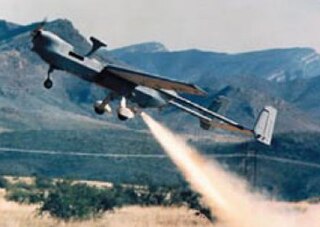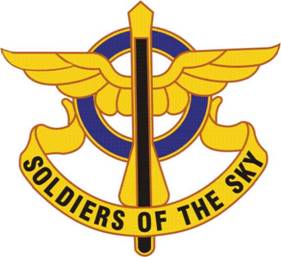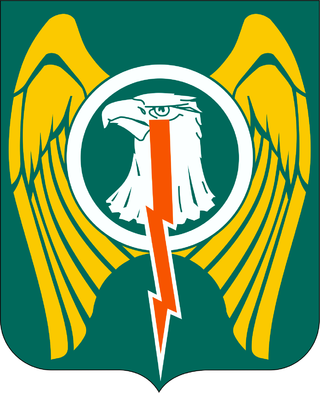
The AAI RQ-2 Pioneer was an unmanned aerial vehicle (UAV) that had been used by the United States Navy, Marine Corps, and Army, and deployed at sea and on land from 1986 until 2007. Initially tested aboard USS Iowa, the RQ-2 Pioneer was placed aboard Iowa-class battleships to provide gunnery spotting, its mission evolving into reconnaissance and surveillance, primarily for amphibious forces.

The IAI RQ-5 Hunter unmanned aerial vehicle (UAV) was originally intended to serve as the United States Army's Short Range UAV system for division and corps commanders. It took off and landed on runways. It used a gimbaled EO/IR sensor to relay its video in real time via a second airborne Hunter over a C-band line-of-sight data link. The RQ-5 is based on the Hunter UAV that was developed by Israel Aerospace Industries.

The AAI RQ-7 Shadow is an American unmanned aerial vehicle (UAV) used by the United States Army, Australian Army, Swedish Army, Turkish Air Force and Italian Army for reconnaissance, surveillance, target acquisition and battle damage assessment. Launched from a trailer-mounted pneumatic catapult, it is recovered with the aid of arresting gear similar to jets on an aircraft carrier. Its gimbal-mounted, digitally stabilized, liquid nitrogen-cooled electro-optical/infrared (EO/IR) camera relays video in real time via a C-band line-of-sight data link to the ground control station (GCS).

AAI Corporation is an aerospace and defense development and manufacturing firm, located in Hunt Valley, Maryland, US. Formerly a wholly owned subsidiary of United Industrial Corporation, AAI was acquired by Textron in 2007. It currently operates as a unit of Textron Systems and employs more than 2,000.
Wheeler-Sack Army Airfield is a military use airport located at Fort Drum, in Jefferson County, New York, United States. It is owned by the U.S. Army.

General Atomics Aeronautical Systems, Inc. (GA-ASI) is a military contractor and subsidiary of General Atomics that designs and manufactures unmanned aerial vehicles and radar systems for the U.S. military and commercial applications worldwide.

Marine Unmanned Aerial Vehicle Training Squadron 2 (VMUT-2) is an unmanned aerial vehicle training squadron in the United States Marine Corps that is transitioning from operating the RQ-21A Blackjack to the MQ-9A Reaper. The squadron is based at Marine Corps Air Station Cherry Point in Havelock, North Carolina and will serve as the MQ-9A Reaper Fleet Replacement Squadron, training UAS officers and enlisted sensor operators. Historically, VMUT-2 provided aerial surveillance, offensive air support, and electronic warfare for the II Marine Expeditionary Force. VMUT-2 falls under the command of Marine Aircraft Group 14 and the 2nd Marine Aircraft Wing.

The General Atomics MQ-1C Gray Eagle is a medium-altitude, long-endurance (MALE) unmanned aircraft system (UAS). It was developed by General Atomics Aeronautical Systems (GA-ASI) for the United States Army as an upgrade of the General Atomics MQ-1 Predator.
The 229th Aviation Regiment is an aviation unit of the United States Army.
The U.S. Department of Defense (DoD) classifies unmanned aerial systems (UAS) into "Groups" according to their size and capability, a joint system that replaced the service branches' separate categorization schemes in 2011.
A Combat aviation brigade (CAB) is a multi-functional brigade-sized unit in the United States Army that fields military helicopters, offering a combination of attack/reconnaissance helicopters, medium-lift helicopters, heavy-lift helicopters, and MEDEVAC capability.
The Northrop Grumman AN/ZPY-1 STARLite Small Tactical Radar - Lightweight is a small, lightweight synthetic aperture radar/GMTI radar used in tactical operations. The radar is under contract to the U.S. Army Communications and Electronics Command for its ERMP General Atomics MQ-1C Gray Eagle Unmanned Aerial System and is manufactured by Northrop Grumman. STARLite weighs 65 lb (29 kg)., occupies 1.2 cubic feet (34 L), and requires less than 750 W of power. The Army began to take delivery of the system in 2010. Also in 2010 the system was ready for deployment to the battlefield.

The U.S. Army Aviation Center of Excellence is the United States Army Aviation Branch's headquarters, and it's training and development center, located at Fort Novosel, Alabama. The Aviation Center of Excellence coordinates and deploys aviation operations and trains aviation officers in a variety of topics, including classroom navigation instruction, aircraft piloting, and basic combat. The current commanding general is Major General Michael C. McCurry II.

The 10th Aviation Regiment is an aviation regiment of the U.S. Army.

The Boeing Insitu RQ-21 Blackjack, company name Integrator, is an American unmanned air vehicle designed and built by Boeing Insitu to meet a United States Navy requirement for a small tactical unmanned air system (STUAS). It is a twin-boom, single-engine monoplane, designed as a supplement to the Boeing Scan Eagle. The Integrator weighs 61 kg (134 lb) and uses the same launcher and recovery system as the Scan Eagle.

The 1st Aviation Brigade is an aviation brigade of the United States Army, stationed at Fort Novosel in Alabama. In accordance with The Naming Commission recommendations Fort Rucker was renamed Fort Novosel in early 2023. It commands three distinctly different battalions—the 1st Battalion, 13th Aviation Regiment; the 1st Battalion, 145th Aviation Regiment; and the 2nd Battalion, 13th Aviation Regiment, the former Unmanned Aircraft Systems Training Battalion at Fort Huachuca, Arizona.
Unmanned aircraft system simulation focuses on training pilots to control an unmanned aircraft or its payload from a control station. Flight simulation involves a device that artificially re-creates aircraft flight and the environment in which it flies for pilot training, design, or other purposes. It includes replicating the equations that govern how aircraft fly, how they react to applications of flight controls, the effects of other aircraft systems, and how the aircraft reacts to external factors such as air density, turbulence, wind shear, cloud, precipitation, etc.

As of January 2014, the United States military operates a large number of unmanned aerial vehicles : 7,362 RQ-11 Ravens; 990 AeroVironment Wasp IIIs; 1,137 AeroVironment RQ-20 Pumas; 306 RQ-16 T-Hawk small UAS systems; 246 MQ-1 Predators; MQ-1C Gray Eagles; 126 MQ-9 Reapers; 491 RQ-7 Shadows; and 33 RQ-4 Global Hawk large systems.

The United States Army Special Operations Aviation Command (USASOAC) provides command and control, executive oversight, and resourcing of U.S. Army Special Operations Command (USASOC) aviation assets and units in support of national security objectives. USASOAC is responsible for service and component interface; training, doctrine, and proponency for Army Special Operations Aviation (SOA); system integration and fleet modernization; aviation resource management; material readiness; program management; and ASCC oversight. USASOAC was established 25 March 2011 consisting of 135 headquarters soldiers and subordinate units totaling more than 3,300 personnel, include the 160th Special Operations Aviation Regiment (Airborne), (160th SOAR (A)) which features 4 Aviation Battalions, the USASOC Flight Company, the Special Operations Aviation Training Battalion, the Systems Integration Management Office, and the Technology Application Projects Office. The first commander of USASOAC was Brig Gen. Kevin Mangum.

The 501st Aviation Regiment is an aviation regiment of the US Army. It draws its history from the original aviation battalion of the 1st Armored Division, the 501st Aviation Battalion. The 501st Aviation Battalion was active with the division in the mid-1980s. It has always been associated with the 1st Armored Division.















